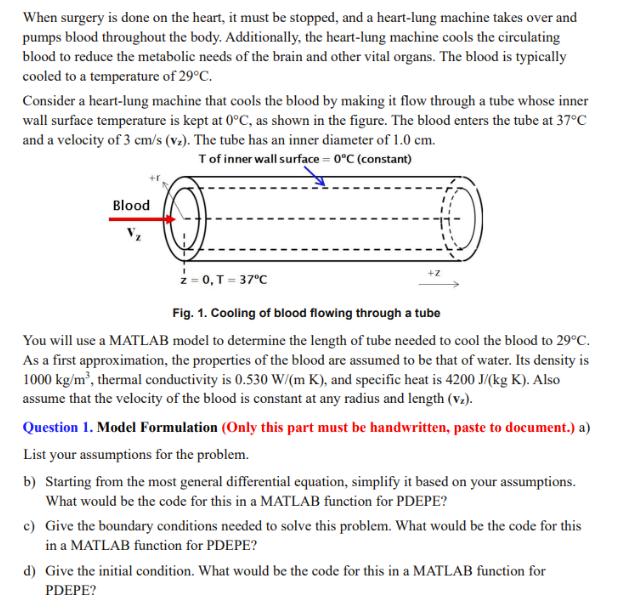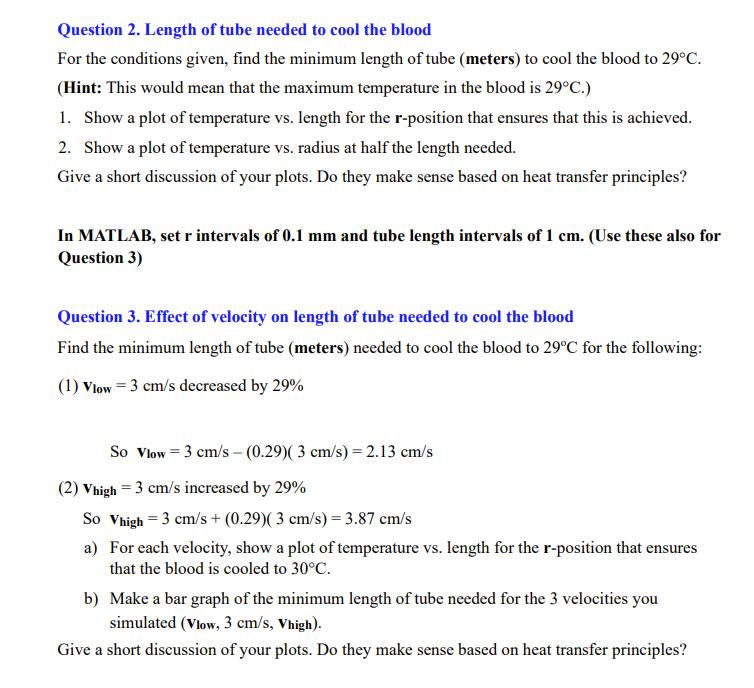Answered step by step
Verified Expert Solution
Question
1 Approved Answer
When surgery is done on the heart, it must be stopped, and a heart-lung machine takes over and pumps blood throughout the body. Additionally,


When surgery is done on the heart, it must be stopped, and a heart-lung machine takes over and pumps blood throughout the body. Additionally, the heart-lung machine cools the circulating blood to reduce the metabolic needs of the brain and other vital organs. The blood is typically cooled to a temperature of 29C. Consider a heart-lung machine that cools the blood by making it flow through a tube whose inner wall surface temperature is kept at 0C, as shown in the figure. The blood enters the tube at 37C and a velocity of 3 cm/s (v). The tube has an inner diameter of 1.0 cm. T of inner wall surface=0C (constant) Blood V =0, T = 37C Fig. 1. Cooling of blood flowing through a tube You will use a MATLAB model to determine the length of tube needed to cool the blood to 29C. As a first approximation, the properties of the blood are assumed to be that of water. Its density is 1000 kg/m, thermal conductivity is 0.530 W/(m K), and specific heat is 4200 J/(kg K). Also assume that the velocity of the blood is constant at any radius and length (vz). Question 1. Model Formulation (Only this part must be handwritten, paste to document.) a) List your assumptions for the problem. b) Starting from the most general differential equation, simplify it based on your assumptions. What would be the code for this in a MATLAB function for PDEPE? +Z c) Give the boundary conditions needed to solve this problem. What would be the code for this in a MATLAB function for PDEPE? d) Give the initial condition. What would be the code for this in a MATLAB function for PDEPE? Question 2. Length of tube needed to cool the blood For the conditions given, find the minimum length of tube (meters) to cool the blood to 29C. (Hint: This would mean that the maximum temperature in the blood is 29C.) 1. Show a plot of temperature vs. length for the r-position that ensures that this is achieved. 2. Show a plot of temperature vs. radius at half the length needed. Give a short discussion of your plots. Do they make sense based on heat transfer principles? In MATLAB, set r intervals of 0.1 mm and tube length intervals of 1 cm. (Use these also for Question 3) Question 3. Effect of velocity on length of tube needed to cool the blood Find the minimum length of tube (meters) needed to cool the blood to 29C for the following: (1) Vlow = 3 cm/s decreased by 29% So Vlow = 3 cm/s - (0.29) (3 cm/s) = 2.13 cm/s (2) Vhigh = 3 cm/s increased by 29% So Vhigh = 3 cm/s + (0.29)( 3 cm/s) = 3.87 cm/s a) For each velocity, show a plot of temperature vs. length for the r-position that ensures that the blood is cooled to 30C. b) Make a bar graph of the minimum length of tube needed for the 3 velocities you simulated (Vlow, 3 cm/s, Vhigh). Give a short discussion of your plots. Do they make sense based on heat transfer principles?
Step by Step Solution
There are 3 Steps involved in it
Step: 1

Get Instant Access to Expert-Tailored Solutions
See step-by-step solutions with expert insights and AI powered tools for academic success
Step: 2

Step: 3

Ace Your Homework with AI
Get the answers you need in no time with our AI-driven, step-by-step assistance
Get Started


